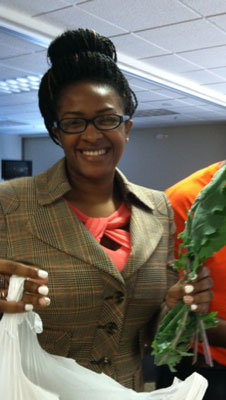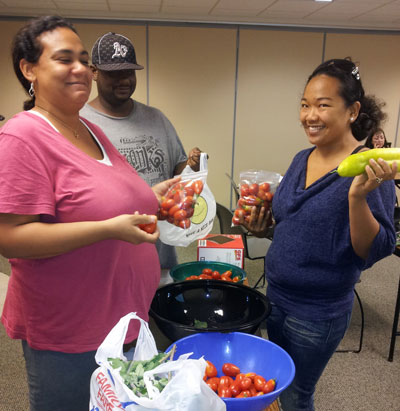Kent County vegetable garden
Growing foods and a sense of community.
This year Kent County Michigan State University Extension staff got together in a cross programming effort to find a unique way to continue to maintain the small, onsite vegetable garden. In the past the plot was part of a youth program that no longer exists. Kent County MSU Extension staff, including Betty Blase, Kendra Wills, Stephanie Marino and myself decided we were not ready to see the plot just go to grass. We pooled together some spend down funds, hired a temporary on-call gardening expert and purchased some start up supplies.
 Marino decided what to plant and selected produce used in Supplemental Nutrition Assistance Program Education (SNAP-Ed) and Cooking Matters demonstration recipes, in turn saving precious programming dollars. She also worked to coordinate the use of the produce with her SNAP-Ed and EFNEP staff.
Marino decided what to plant and selected produce used in Supplemental Nutrition Assistance Program Education (SNAP-Ed) and Cooking Matters demonstration recipes, in turn saving precious programming dollars. She also worked to coordinate the use of the produce with her SNAP-Ed and EFNEP staff.
Wills helped by selecting the growing expert, Tessa Kwant. Kwant, the back-bone of the project cleared, tilled, planted, watered, weeded and harvested, along with providing staff with weekly emails detailing what and how much was harvested. This communication was essential since any produce staff needed was used, and any that wasn’t needed was delivered to the local senior food pantry.
Chanelle Charity working the vegetable garden.
SNAP-Ed staff Gloria Martin and Amy Prins worked to incorporate the produce into their Cooking Matters classes. They made sautéed greens using kale from the garden. They gave baggies of tomatoes, zucchini and green beans to program participants to reinforce a lesson about fruits and vegetables, from Eating Right is Basic. They also gave away two kinds of kale grown in the garden. The participants were curious and wanted to know what kinds of vitamins they received from kale, how to cook it, where to get it and what does it taste like. “Giving it to them (class participants), gave them a chance to try it, and find out they liked it,” said Martin.
SNAP-Ed staff Jane Higley, Deb Shattuck, Yesi Velasco and Latoyia Thomas took kale chips to groups they worked with. “We sprayed the kale with cooking spray, sprinkled garlic powder and parmesan cheese on it and baked it at 350 degrees Fahrenheit for six to eight minutes, just until it got crisp. Participants, both youth and adults, who had never tried kale before, loved the kale chips,” Higley said.
I, myself used the produce as an incentive for two series that I instruct, RELAX and Building Strong Adolescents. Harvested produce was offered for participants to choose from to take home. One young man commented on seeing the bowl of green beans, “Those are real green beans? I have never seen a green bean that didn’t come out of a can! Can you even eat those? I don’t even know how to cook them.” I told him how to cook fresh green beans and reluctantly, he did take some home, but still said he would have his grandma help him cook them.

Sunshine Mansfield, Donald Thomas, and Dinah Hoover with some veggies.
Toward the end of the season, on one warm summer evening participants were invited to go to the garden after class to harvest together. The best part was watching the participants bond over what they were picking, listening to them tell each other how to prepare the bounty.
The staff estimates they spent about $1,200 of the $2,400 they set aside and hopes to continue to fund the garden in 2014. It’s not just about the food produced, it’s about giving people a chance to try something new, something fresh and experiencing the sense of community that this type of a project provides – not just for the participants but for the staff involved.



 Print
Print Email
Email



